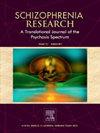Sleep disturbances in individuals with first episode psychosis and clinical high-risk states: A systematic review
IF 3.6
2区 医学
Q1 PSYCHIATRY
引用次数: 0
Abstract
Background
Sleep disturbances are increasingly recognized as relevant components of the psychopathology of psychosis, emerging early in the illness trajectory and persisting over time. Indeed, individuals with first-episode psychosis (FEP) commonly experience disruptions in sleep architecture, including reduced sleep efficiency, increased sleep latency, and altered time spent in various sleep stages. These abnormalities are also reported in individuals with Clinical High-Risk (CHR) states, showing a significant correlation with cognitive and affective impairments.
Methods
We conducted a systematic search across four main electronic databases, including PubMed, Web of Science, EMBASE, and PsycINFO, to specifically identify studies examining sleep parameters in FEP and CHR subjects compared to healthy controls. Eligibility criteria included quantitative and qualitative assessments of sleep.
Results
The final selection consisted of 25 studies corresponding to 1255 patients and 342 healthy controls. Increased sleep latency and alterations in slow-wave sleep were frequently reported. These findings highlight the pervasiveness of sleep disturbances in individuals with early psychosis, though further research is needed to clarify their clinical significance. Evidence also suggests bidirectional relationships between sleep disturbances and psychotic symptoms, with sleep disruptions potentially exacerbating cognitive and emotional dysfunctions in FEP and CHR individuals.
Conclusions
Sleep disturbances in FEP/ CHR populations are pervasive and may reflect underlying neurobiological mechanisms implicated in psychosis. These abnormalities represent modifiable targets for early intervention, with the potential to improve clinical and functional outcomes. Future research should explore longitudinal associations and the efficacy of sleep-focused interventions in the early stages of psychotic disorders.
首发精神病和临床高危状态患者的睡眠障碍:一项系统综述
背景:睡眠障碍越来越被认为是精神病精神病理的相关组成部分,出现在疾病轨迹的早期,并随着时间的推移而持续。事实上,首发精神病(FEP)患者通常会经历睡眠结构的中断,包括睡眠效率降低、睡眠潜伏期增加、不同睡眠阶段的时间改变。这些异常在临床高危(CHR)状态的个体中也有报道,显示出与认知和情感障碍的显著相关性。方法我们对PubMed、Web of Science、EMBASE和PsycINFO等四个主要电子数据库进行了系统检索,以确定与健康对照组相比,FEP和CHR受试者睡眠参数的研究。入选标准包括睡眠的定量和定性评估。结果最终入选25项研究,对应1255例患者和342例健康对照。睡眠潜伏期的增加和慢波睡眠的改变经常被报道。这些发现强调了睡眠障碍在早期精神病患者中的普遍性,尽管需要进一步的研究来阐明其临床意义。证据还表明,睡眠障碍与精神病症状之间存在双向关系,睡眠中断可能加剧FEP和CHR患者的认知和情绪功能障碍。结论睡眠障碍在FEP/ CHR人群中普遍存在,可能反映了与精神病有关的潜在神经生物学机制。这些异常是早期干预的可修改目标,具有改善临床和功能结果的潜力。未来的研究应该探索以睡眠为中心的干预在精神病早期阶段的纵向关联和疗效。
本文章由计算机程序翻译,如有差异,请以英文原文为准。
求助全文
约1分钟内获得全文
求助全文
来源期刊

Schizophrenia Research
医学-精神病学
CiteScore
7.50
自引率
8.90%
发文量
429
审稿时长
10.2 weeks
期刊介绍:
As official journal of the Schizophrenia International Research Society (SIRS) Schizophrenia Research is THE journal of choice for international researchers and clinicians to share their work with the global schizophrenia research community. More than 6000 institutes have online or print (or both) access to this journal - the largest specialist journal in the field, with the largest readership!
Schizophrenia Research''s time to first decision is as fast as 6 weeks and its publishing speed is as fast as 4 weeks until online publication (corrected proof/Article in Press) after acceptance and 14 weeks from acceptance until publication in a printed issue.
The journal publishes novel papers that really contribute to understanding the biology and treatment of schizophrenic disorders; Schizophrenia Research brings together biological, clinical and psychological research in order to stimulate the synthesis of findings from all disciplines involved in improving patient outcomes in schizophrenia.
 求助内容:
求助内容: 应助结果提醒方式:
应助结果提醒方式:


